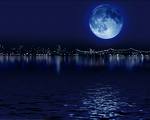 It happens only once in a blue moon — and scientists say a blue moon is exactly what we’ll see in the skies this New Year’s Eve. Don’t expect an azure glow over our lunar satellite, however. The term “blue moon” simply refers to the second full moon in a calendar month, something that hasn’t happened on a New Year’s Eve for nearly 20 years, NASA says. December 1990 ended with a blue moon, and many New Year’s Eve parties were themed by the event,” said Professor Philip Hiscock of the department of folklore at Memorial University of Newfoundland, in Canada. “It was a lot of fun.”
It happens only once in a blue moon — and scientists say a blue moon is exactly what we’ll see in the skies this New Year’s Eve. Don’t expect an azure glow over our lunar satellite, however. The term “blue moon” simply refers to the second full moon in a calendar month, something that hasn’t happened on a New Year’s Eve for nearly 20 years, NASA says. December 1990 ended with a blue moon, and many New Year’s Eve parties were themed by the event,” said Professor Philip Hiscock of the department of folklore at Memorial University of Newfoundland, in Canada. “It was a lot of fun.”
Most months have just one full moon, because the 29.5-day cycle of the moon matches up pretty well with the length of calendar months. Occasionally, there will be two full moons in a month, something that happens about every 2½ years, NASA says.
But a blue moon on December 31 is rare.
It is possible for the moon to have a cerulean hue, NASA says, but that’s sometimes caused by fine dirt circulating in the Earth’s atmosphere or the dark blue tone of the sky.
A blue moon hasn’t always meant the second full moon in a month. Hundreds of years ago, it simply meant “never” or “absurd,” Hiscock said.
“The phrase ‘blue moon’ has been around a long time, well over 400 years, but during that time its meaning has shifted,” he said. “I have counted six different meanings which have been carried by the term, and at least four of them are still current today. That makes discussion of the term a little complicated.”
When the Indonesian volcano Krakatoa erupted in 1883, it put so much dust in the atmosphere that the moon actually appeared blue — an event so unusual that the term “once in a blue moon” was coined, according to NASA’s National Space Science Data Center. The effect lasted for almost two years, Hiscock said.
Full moons used to have 12 names, one for each month, such as “harvest moon,” NASA said. The term “blue moon” referred to the 13th full moon in a year.
The term acquired its current meaning in the 1940s, after the Farmer’s Almanac of Maine offered an astronomical definition of a blue moon “so convoluted that even professional astronomers struggled to understand it,” NASA wrote on its Web site.
A writer at Sky and Telescope magazine in the late 1940s tried to explain the almanac’s definition by saying it referred to the second full moon in a month.
“That was not correct, but at least it could be understood,” NASA wrote. “And thus the modern blue moon was born.” CNN

Because of the roughly eleven-day difference between twelve lunar months and one solar year, the year lengths of the Hebrew calendar vary in a repeating 19-year “Metonic” (A period of 19 tropical years is almost exactly equal to 235 months, and rounded to full days counts 6940 days. The difference between the two periods of 19 tropical years and 235 months is only 2 hours.) cycle of 235 lunar months.
An intercalary lunar month is added according to defined rules every two or three years, for a total of 7 times per 19 years.
Seasonal references in the Hebrew calendar reflect its development in the region east of the Mediterranean Sea and the times and climate of the Northern Hemisphere. The Hebrew calendar’s year is longer by about 6 minutes and 25+25/57 seconds than the present-day mean solar year, so that every 224 years, the Hebrew calendar will fall a full day behind the modern fixed solar year, and about every 231 years it will fall a full day behind the Gregorian calendar year.
The solar year does not have a whole number of days (it’s about 365.24 days), but a calendar year must have a whole number of days. The only way to reconcile the two is to vary the number of days in the calendar year.
by US it is ‘bakesseh lyom chagainu’
its a shame its cloudy!!!!!!!!!!!!!!!!!!!!!!!!!!!!!!!!!!!!!!(hahaha)